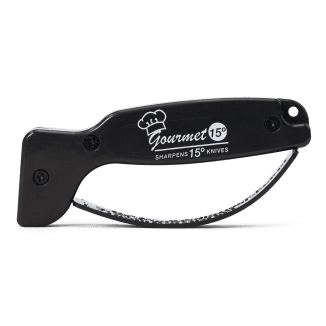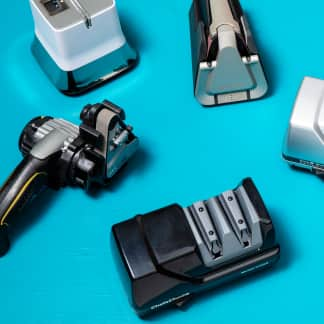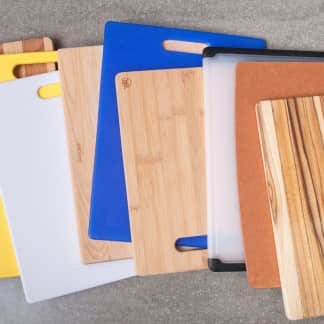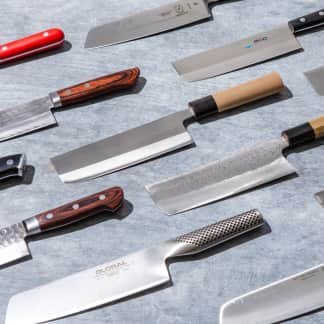A good manual knife sharpener is a convenient way to maintain your kitchen knives. These devices are designed to sharpen blades to specific edge angles (check with the knife manufacturer if you’re not sure of its angle). Our overall favorite, the Chef’sChoice Pronto Diamond Hone Manual Knife Sharpener, quickly put a keen 15-degree edge on knives. It’s inexpensive and stores in a drawer.

Our Best Buy, AccuSharp Gourmet Series 15 Degree Knife Sharpener (and AccuSharp Knife and Tool Sharpener for 20-degree blades), is even smaller, faster, and cheaper, and highly effective, but it left knife edges less polished than the Chef’sChoice Pronto.
For those who don’t mind spending more and following a longer process for the ability to put a customized edge on blades ranging from 15 to 30 degrees, the Work Sharp Professional Precision Adjust Knife Sharpener is our upgrade pick.
Electric sharpeners sharpen faster than most manual sharpeners, and our top pick can repair a chipped knife, which manual models can’t do. Read our review of electric knife sharpeners for more information. If you are interested in using a whetstone, our guide has step-by-step instructions.
How to Use a Whetstone
No other sharpener can hone and sharpen such a varied amount of knives.Manual knife sharpeners are handheld or countertop tools that help you care for kitchen knives. Unlike electric sharpeners, which use power to rotate an abrasive belt or wheel, manual models rely on you to move the knife against the abrasive material or vice versa. Unlike whetstones, manual sharpeners include guides to help put the desired edge angle on your blade, so they require less skill. Compared to electric models, manual sharpeners are slower and can’t repair deep damage such as chips in the blade. On the plus side, they tend to be smaller and less expensive and sharpen well for regular maintenance—if you get the right sharpener.
All sharpeners are designed to work with knives of specific edge angles. Traditionally, European knife manufacturers sharpened to 20 degrees and Japanese knife makers to 15 degrees (or less). But over the past decade or so, European knives have trended toward narrower edge angles too. If the metal is strong enough to support the narrower edge, it can make for a sharper-feeling blade. Thinner, narrower edges concentrate force so that it’s easier to push the blade through food. We generally prefer kitchen knives with edge angles of about 15 degrees or smaller, including our longtime favorite chef’s knife, the Victorinox Swiss Army Fibrox Pro 8" Chef’s Knife and our Best Buy, the Mercer Culinary Millennia 8-Inch Chef’s Knife. But since not everyone has a knife with a 15-degree angle, we also tested sharpeners designed to work for 20-degree angles, ones that can do both 15- and 20-degree angles, and adjustable models that can handle an even wider range of angles. If you’re not sure what edge angle your knife is, check our reviews or contact the manufacturer.
To find the best manual sharpeners, we dulled new copies of our Best Buy chef’s knife and sharpened them on each model. If sharpeners performed well, we repeated the test with our favorite carbon-steel chef’s knife, which is made of harder steel. We evaluated the time and effort it took to achieve a good result, whether the sharpener scratched the knife, and how the sharpened edge looked under a microscope.



What’s the Best Material for a Knife Sharpener?
Sharpeners in our lineup used different abrasive materials—carbide (a mix of metal and carbon), ceramic, or diamond—to reshape the knives’ edges. Carbide and ceramic have a high coefficient of friction, said Mike Tarkanian, senior lecturer in the department of Materials Science and Engineering at the Massachusetts Institute of Technology. This means that they’re relatively sticky and “grab” at the blade’s surface, which makes them more prone to leaving the blade edge rough. While the roughness along the edge can work like mini serrations, helping knives slice easily into food, the knife won’t cut quite as precisely and neatly. Diamond is much harder, so its coefficient of friction is relatively low, which helps it glide over a blade as it sharpens and produces a smoother, sharper edge. Another important factor to choosing an abrasive material is the longevity of the material—and by extension, the sharpener itself. Ceramic and carbides are softer than diamond and degrade more quickly, potentially shortening the sharpener’s lifespan.
What Are the Three Types of Manual Sharpener?
Sharpeners in our lineup used three very different approaches to sharpening:
- Pull-through models have the user pull and/or push the blade through one or more V-shaped slots designed to keep the knife at a specific angle against the abrasive. A related style has you pull a v-shaped abrasive over the blade.
- Controlled-angle systems hold the knife with a clamp while you slide the abrasive along the knife edge; the abrasive is attached to a rod that keeps it at the desired angle. You swap abrasives, from coarse to fine, as sharpening progresses.
- Rolling sharpeners use a cylinder with coarse and fine abrasives on its ends. You roll the cylinder on the countertop along the upturned blade, which is held by a magnetic block.
As we worked with each model, here’s what we learned to look for (and avoid) in a good manual sharpener.
What to Look For
- Diamond Abrasives: A good abrasive should be able to reshape and polish the knife’s entire cutting edge; diamond was the most effective. We also found that sharpeners with at least two stages of diamond abrasives, coarse and fine, were most effective, though we liked one model that used a single stage of tungsten carbide. Since tungsten carbide is less durable than diamond abrasives, look for sharpeners with reversible or replaceable abrasives.

- Clear Instructions: Specific instructions made us feel confident and ensured better results. Some models’ sketchy manuals sent us scrambling online for more information, while others had ambiguous directions that left too much up to users to experiment; it was frustrating and annoying that we were endangering our knives in order to learn.
- Good Angle Control: Sharpeners that made it easy to hold the blade and/or the sharpening medium at the correct angle helped us get a better, sharper, and more consistently shaped edge on knives. On the pull-through models, the best had narrow slots of at least ¾ inch depth that made it easy to maintain the desired angle.


On pull-through sharpeners, the best had narrow slots of at least ¾ inch depth that made it easy for us to hold the knife at the correct angle. Too-shallow slots (right) let the knife wiggle and slide out of position as we worked.
- Easy (or No) Assembly: The less you have to set up and tweak the sharpener, the more likely you will be to use it. We preferred models with fewer parts.
- Speed: We prefer devices that can sharpen a kitchen knife in a few minutes, though we know that some people don’t mind taking more time in exchange for a more customizable sharpening process, especially for high-end or specialty knives. In our testing, customizable models took up to five times as long as simple models to sharpen a single blade (though this may speed up once you’ve homed in on the best practice for your knife).
Which Knife Sharpening Method Is Right For You?
Sharper knives are safer and make cleaner, more even cuts. But approaches to sharpening abound. Here are our favorite options.What to Avoid
- Ineffective Abrasive Material: It was disappointing to follow instructions and find the knife still dull or unevenly sharpened. Often, when we sharpened more, results didn’t improve, or worsened. This is likely because the abrasive, whether diamond, ceramic, or carbide, was too finely textured.
- Rolling Sharpeners: The cylinders of both rolling sharpeners we tested were too short to sharpen the full blade of our knives. Suggested fixes were so awkward that we eventually gave up.

- Unclear Instructions: Incomplete or ambiguous instructions were frustrating. Some brands offered very different options for how to use their sharpener, leaving users to hunt down videos and other information online and experiment, which we’d rather not do with our beloved knives.
- Poor Angle Control: Models that didn’t help control the angle, either with slots too shallow to guide the blade or with lots of wiggle room, sharpened less consistently.
- Time-Consuming Process: We preferred faster sharpening processes so that we could return to cooking. Models in our lineup took anywhere from less than 30 seconds to 30 minutes— or more—to sharpen a single blade. If sharpening takes too much time and effort, we fear we won’t do it.
The Tests
- Assign new copies of our Best Buy Mercer Culinary Millennia 8-inch Chef’s Knife to each sharpener
- Dull and resharpen each blade, testing sharpness at points along the blade using edge testing machine as well as slicing paper and tomatoes.
- Repeat test with recommended models using the Bob Kramer 8" Carbon Steel Chef’s Knife by Zwilling J.A. Henckels
- Examine sharpened edges under microscope
How We Rated
- Performance: We rated models on their ability to restore a uniformly sharp edge to kitchen knives.
- Ease of Use: We assessed how easy, efficient, and comfortable it was to use each sharpener.
- Knife Condition: We evaluated knives after the sharpening process with and without a microscope to assess whether the sharpeners had caused damage, either functional or cosmetic.



















